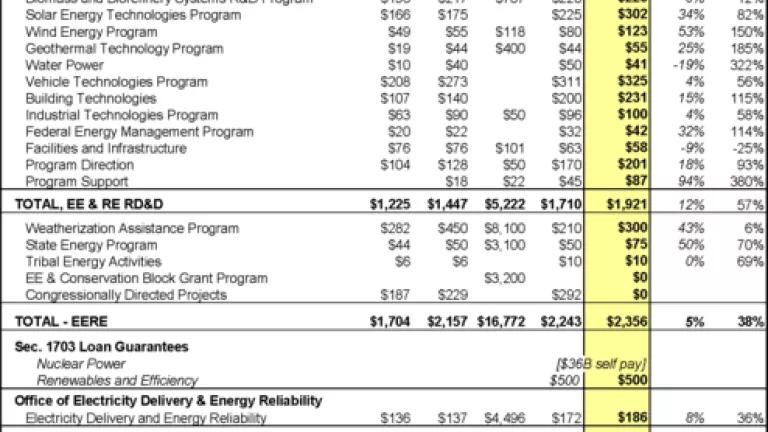
The Obama Administration today released its 2011 budget, to mostly strong support from the environmental community (albeit with major concerns about $36 billion funding increase for self-pay nuclear loan guarantees).
Given clean energy’s status as the must have political accessory of the season, there has been considerable attention paid by the White House, and those covering the budget, to funding for renewable energy and energy efficiency (good additional analysis here, here and here). And overall, this year’s budget request for the Department of Energy doesn’t disappoint, outside issues with nuclear energy. Having jointly published a recent set of recommendations for energy and environmental spending priorities in fiscal year 2011, we feel there’s a lot to like in this budget from a clean energy perspective. Those interested in the actual numbers should go here, although for true masochists, the 800+ page annual Justification never fails to disappoint. Several of the key budget requests are outlined in the chart at the bottom of this post (apologies if difficult to read - too much information, not enough space).
The Good:
- Despite concerns around the recently announced budget freeze, the overall budget for the Office of Energy Efficiency and Renewable Energy (where most direct federal spending on clean energy occurs) would increase by 5% from last year, to around $2.4 billion. If one accounts for the absence of earmarks (i.e. “Congressionally Directed Projects”) in this year’s budget, compared to previous years, the total EERE budget for FY11 would be in fact be over 10% higher.
- Funding for select renewables would increase dramatically – with funding for solar, wind and geothermal RD&D seeing annual increases in the range of 25%-50%. Other programs (biomass, vehicle technologies, buildings, industrial efficiency) would increase slightly or stay flat.
- Funding for from some efficiency programs (i.e. weatherization, building technologies) will improve somewhat, although for yet another year, no funding was allocated for the conservation block grant program (designed to create sustainable building retrofit programs at the community level). Given the considerable investment in this program via the Stimulus Act, it would be a shame to lose momentum on this important effort.
- Spending on basic science and transformational, next generation research would receive significant funding increases. The Office of Science, which funds fundamental basic science research, almost exclusively through the national labs, would gain a 4% bump to over $5.1 billion. Energy Innovation Hubs and Energy Frontier Research Centers – two efforts launched by Secretary Chu to foster new pathways to innovation – would receive over $100 million each, and ARPA-E, the new entity currently focused on commercializing advanced clean technologies – would see $300 million.
- The new budget eliminates 12 separate tax breaks for oil, gas, coal companies which will apparently result in $30 billion in savings over the next decade. This builds on the global commitments that the U.S. has made, and will hopefully foster similar efforts by other countries. NRDC has long supported the elimination of subsidies for mature fossil fuels, and is encouraged by this activity.
- Overall, looking at funding from 2008 fiscal year, to this request, one begins to see the stable, sustained increases in funding that have long been recommended by experts, industry and investors alike. One of the challenges with dramatically scaling up clean energy innovation spending is that building the staff, infrastructure and systems to manage the inflow of dollars can take time, but is an imperative step in order to avoid wasteful allocations. This year’s EERE budget (a decent proxy for government spending on clean energy overall) would increase spending by 38% since 2007, a significant jump. However, with many experts calling for a doubling and tripling (and more) of RD&D funding at DOE, we still have a long way to go.
The Concerning:
- The primary concern remains nuclear loan guarantees, although that is muted somewhat by the decision to withdraw the Yucca Mountain license application, and general nuclear energy R&D. The $36 billion in loan guarantees for the nuclear industry would, as my colleague Chris Paine puts it, unnecessarily subsidize “a high-cost, subsidy-dependent, radioactive-waste generating, water-depleting, non-renewable energy source that still carries with it the low probability of a high-consequence accident.” Additionally, while we are excited by the potential increase in funding for renewables, nuclear energy R&D expenditures would still amount to around $800 million, which is more than the combined amount provided for biomass, biofuels, solar, wind, geothermal and water power technologies.
No budget will ever be perfectly aligned with all interests. However, for those interested in developing current and next generation clean technologies, this budget can be viewed as another strong step in the right direction towards building the foundation for a new clean energy economy.
UPDATE: thoughts from my colleague Brian Siu specifically on the Vehicle Technologies program: "The President’s 2011 budget proposes $325 million for DOE’s advanced vehicle technologies program. This continues annual funding increases from $267 million in 2009 and $312 million in 2010. The program develops and deploys a range of beneficial automotive technologies such as lightweight materials, electric motors, advanced batteries and vehicle efficiency measures. To that extent, we believe that the Administration’s proposed increase serves the nation’s strong interests in minimizing global warming pollution and imported oil."